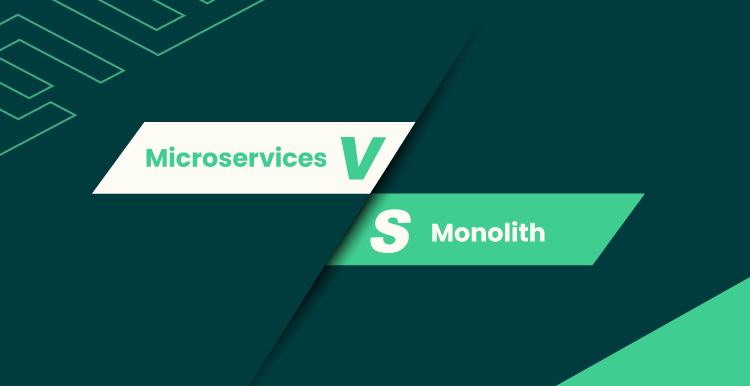Each time you decide to relax, your competitors wave at your clients. Who knows when will be the time your clients decide to wave back? To prevent this, do not forget to improve and boost your business even if it is stable and brings you a regular income.
Can you fix the problem of a high shopping cart abandonment rate? Great, let’s do this. Are you going to facilitate product matching? If you do, you are on the right way. But what should you do if you see an urgent problem that cannot be fixed on the current platform you use? It may be a sign that you should look for other solutions.
For sure, there is no need to rush into ecommerce migration as soon as you notice some new issue. Still, reviewing the list of best options may give you a better understanding of where money should be invested and how to facilitate business growth.
Welcome to the Forbytes’ ecommerce replatforming guide. In this article, we discuss ecommerce replatforming reasons and steps and review ecommerce platforms that are frequently chosen as migration destinations.
What Is Replatforming and Why Is It Important?
Replatforming means moving your online store from one ecommerce platform to another. This process is very responsible and requires you to be specific about your goals. As a rule, businesses expect to get a better user experience, performance, and functionality after replatforming. Switching ecommerce platforms requires a big effort but can bring you big benefits afterward. Here are some of the reasons to perform the ecommerce replatforming:
Reasons for eCommerce Replatforming
For many ecommerce stores, the first choice of ecommerce platform is not conscious enough. Since they are only starting their digital transformation, they have little understanding of the features they need for running an online business. As their sites grow, they start to realize that some ecommerce platforms suit their business needs better than others. Here are some of the common reasons that make companies start a migration process:
- Feature gaps. You need a particular function that would simplify your work but your current ecommerce platform lacks it. A new ecommerce platform may help solve this problem.
- Performance. If you or your clients witness bugs and tech problems that are not fixed by the platform’s maintenance team, study other options for running an ecommerce business.
- Speed. The low loading speed takes away your chance to grow and increase your audience. As you know, users leave websites that are loaded for more than 3 seconds.
- Limited admin functionality. If the website looks good for your customers but is inconvenient for employees, it’s time to upgrade your ecommerce store.
- Poor UX. If the chosen software provides a poor customer experience and has an outdated UI UX design, this may also be a sign that you need a new ecommerce platform. Check our article on UX trends for ecommerce to be aware of what’s relevant today.
- High costs. It can turn out that you pay for the functionality that is granted for free on other ecommerce platforms. Maybe it would be better to save money to be invested in something no less important.
- Integration availability. You may lack the freedom of action that is provided by third-party integrations available on another, truly scalable platform.
- The goal to grow. You see that your existing platform satisfies your current needs but as you plan to grow, it will not give you enough tools for scaling.
To be brief, the following factors should be considered in the migration process:
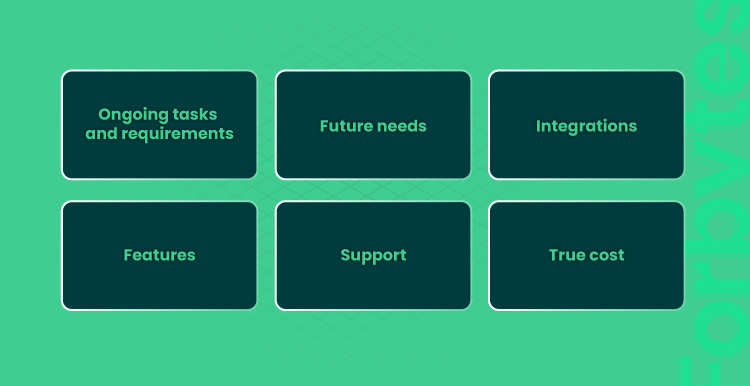
These are the most common reasons why a business owner starts looking for ecommerce migration services. Now, let’s move on to step-by-step planning of the very process.
eCommerce Replatforming Checklist
eCommerce platform migration should start with a plan. This checklist will help you not to miss anything vital while moving from one platform to another.
- Outline the gaps to be solved with migration. Analyze what dissatisfies you, your employees, and your customers while using the platform. Conduct surveys and try to imitate your client/employee journey to see their pains. By having the list of deficiencies at hand, you will clearly see what benefits of ecommerce platforms matter to you the most.
- Discuss your idea with stakeholders. Before replatforming e-commerce, organize a meeting with your team/key stakeholders/investors. You need to realistically understand the costs it will take, the damage and inconveniences migration may bring, etc.
- Compare platforms for ecommerce site migration. Study the costs, pros, and cons. Look at other companies using the given platform. Do they operate in the same sector/country/segment as you do? Answering these questions may give you the right direction.
- Narrow your options to 3-5 platforms. Now, it’s time to request a demo from these companies, read client reviews, and watch video guides. It will help you to make the right decision in the next step.
- Choose a platform for ecommerce migration. Choose the most suitable option. It’s great if the chosen platform offers a free trial. In this case, you may try to use it for some time before completely migrating.
- Back up your data. Migration increases the risks of data loss so you need to create a data backup in advance. Ask ecommerce development specialists to advise you on the best ways to secure your customer data and prevent losses.
- Design your ecommerce store. Usually, the opportunity to design a new ecommerce store is available before migration. With new templates and plugins, you may use the migration process as a chance to refresh and modernize your website’s design. You can experiment with elements, forms, usability aspects, etc.
- Migrate to a new platform. When you are sure that the decision is worth the candle, migrate your data to a new platform. You may need to hire a third-party partner to ensure a smooth data migration and prevent errors.
- Test how it works. Before your site goes live, it should be multiply tested not only by you but also by a third party. Every function, feature, and form should be checked before presenting the change to your customers. Remember: the first impression matters a lot.
- Inform your clients. Let your audience know about the changes. Your users need to see your desire to improve for customers and add innovation and convenience to the services you provide.
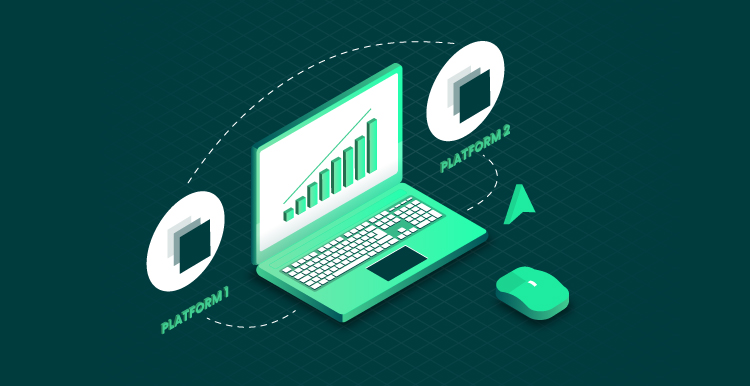
Best Replatforming Destinations to Choose From
Today, we will go through some of the most popular platforms to consider for the migration process. Let’s analyze the pros and cons of each platform, check famous cases of use, and make a short conclusion to help you find the needed option.
WordPress
WordPress is a universal content management platform that can be adjusted to the needs of ecommerce businesses. More than 450 million websites use WordPress, with the figure rapidly growing. Each day, at least 500 new websites are built with the help of this platform. WordPress offers its users various templates and themes that help businesses customize online stores. Different plugins, elements, and new features can be added to the platform to facilitate commerce. The function of blocks available on WordPress allows for easy content publication and management even for those who have never dealt with programming.
Pros
- Easy to use. WordPress has a simple design with understandable sections and functionality. Some may call the design outdated, but for the majority, the simplicity of design is a big benefit.
- Management is possible with no code experience. WordPress is a good choice for managers who have never dealt with code. Publishing new ecommerce content is intuitive. You can use blocks to manage content in visual form instead of working with code.
- SEO-friendly platform. Adding necessary plugins helps you build a content structure that will improve your search engine optimization.
- Free of charge. WordPress can be used for free by any business. Sure, the migration and customization will cost you money, but the platform is free-to-use.
- Stability. WordPress was released in 2003. From this time on, there has grown a whole generation of WordPress engineers with a vast experience in ecommerce replatforming.
- Expandible with plugins and features. Depending on your needs, you may add different plugins and features to your e-store to make it more memorable and user-friendly.
- Large community. Since WordPress is open-source, there always are many people eager to help others with issues and improve the platform.
Cons
- Vulnerability. Basic security guarantees offered by this platform provider are weak. If you choose WordPress for ecommerce migration, you need to integrate ecommerce security plugins and update your website regularly.
- Raw base. The basic functionality of WordPress gives little opportunity. In fact, you get a raw base that should be boosted with integrations of various purposes.
- Costly maintenance and customization. Even though WordPress is free, everything comes with a cost. The more customized ecommerce store you want, the more costs you need to invest.
Interesting Features
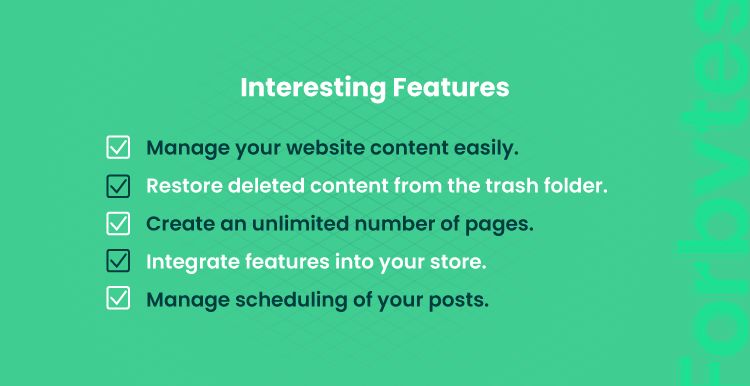
Famous Cases of Use
- PlayStation. This company uses WordPress to power its blog where they share useful gaming tips, inform about game updates, publish news, etc.
- Sony Music. This recognized music brand powers its website with WordPress. They use the platform to showcase Sony Music artists, share news, and so on.
- TED Blog. The website uses WordPress to feature insights from TED videos and share news on upcoming Ted events.
Conclusion
Because of the limited opportunities of WordPress, this is a good choice only for small-size ecommerce stores with a basic range of products and functions.
Shopify
Moving to Shopify is one more idea for e-commerce migration. This is an ecommerce solution that offers everything needed to manage an online store. Shopify is very popular among starting businesses that know little about coding, web design, programming, etc. The revenue generated on Shopify websites is growing at 110% yearly. As for now, Shopify powers more than 1 million websites worldwide. There are 3 Shopify plans that users can choose from. There is a Basic, Shopify, and Advanced plan. There also is a free trial in which you have 14 days to register and try how this ecommerce platform works.
Pros
- Quick setup. Shopify allows you to start quickly. You can choose Shopify both in case of ecommerce migration and when building your ecommerce store from scratch.
- Big choice of themes. You can customize your store with the help of responsive and well-tested themes. This eliminates the chances that your users will face usability problems.
- Security. Shopify takes care of hosting and software reliability. Your client data and sensitive business information are protected thanks to quality maintenance and regular updates.
- Reliability. Shopify is one of the most reliable platforms so you can find a lot of video guides, courses, and documentation that teaches users how to sell on this platform.
- Apps to automate your business. Plugins can be used to automate many ecommerce processes. These include notifying customers, analyzing their behavior, building the right logic of commerce, and more.
- Mobile-friendly. Shopify is ready for the rise of m-commerce that we witness today. All themes are customized to any screen size and device, including mobile.
Cons
- Coming with a price. You need to pay for a plan and plugins to ensure better customization and convenience for your clients.
- No function of integrating the back-office system. It makes it harder for your employees to do their work conveniently. There is no separate system for finance, content, order management, etc.
- Not the best for content-rich ecommerce stores. If you only need to place goods on your website and name them, choose Shopify. If you want to enrich your e-store with unique and engaging content — consider another solution.
- Your data is in someone else’s hands. This increases the risk that someone will ruin your data management or pass the authority into unreliable hands.
- Not intuitive. Because of some common and deeply rooted Shopify problems, you may lose your potential customers.
Interesting Features

Famous Cases of Use
- Kylie Cosmetics. Since 2015. the brand owned by Kylie Jenner and Coty Inc. uses Shopify to sell cosmetics.
- Whole Foods. Whole Foods belongs to Amazon Inc. and combines Amazon Prime with Shopify Plus to manage its online grocery store.
- Red Bull GMBH. This is the 9th largest business using Shopify. The platform has helped the company cross the point of $12 billion in market value.
Conclusion
Choose this platform if the path to order fulfillment and purchasing is easy on your site. If there is too much customization, a lot of content, or a complex customer journey — check on other options for the replatforming process.
Magento
Magento is definitely one of the best choices for running an ecommerce business, from small local e-stores to big enterprises. This is an open-source platform that enables users to choose the design, manage functionality, and publish content without compromising on client convenience. Our recent article compares Magento vs Shopify in terms of their key functions and benefits. If you choose between these two, check out this post to learn more.
The audience of Magento includes both ordinary people having no technical skills and ecommerce developers. This ecommerce platform is used by nearly 12% of all e-stores, which makes up 1.2% of the Internet as a whole. This is because of the benefits Magento offers.
Pros
- Has both free and paid versions. There are Magento Open Source and Magento Commerce. Depending on your needs, you may choose one and then migrate to another.
- Regular updates. Magento is regularly updated and improved. It also released a big update to Magento 2, which offers even more benefits. Check our Magento 1 to Magento 2 migration guide for more.
- Easy management. There are lots of features to be used to ease the process of ecommerce management.
- Loading speed. Magento offers high loading speed even under heavy traffic.
- Flawless client experience. Making your ecommerce store user-friendly is now possible with Magento. The platform allows for intuitive and convenient content management.
- SEO-focused. Magento functionality will enable you to build URLs effectively. Moreover, Magento automatically optimizes your store to be responsive on any device and screen.
- Security. Regular Magento security updates keep customer data safe and eliminate any vulnerabilities.
- Scalability. If you start with a small shop and then decide to scale, there will be no need for you to change the platform. Magento gives scalability opportunities for effective website performance and growth.
- Lots of Magento extensions available. With extensions integrated into your ecommerce store, you will address your business needs more specifically. These include marketing, accessible analytics, accounting, ecommerce security, etc. In our new post, you can check the metrics to be tracked for effective business performance.
Cons
- The need for developers. To improve your online store, you will need the help of software engineers. The Magento system is easy to use but not that easy to customize. A dedicated team model may be a good solution for Magento development.
- Time-consuming. It will take you time to launch a Magento store. Magento is a more complex platform compared to others because of its multi-layered nature.
- The choice of hosting. Shared hosting is not a good idea if you want to build a performant online store. It is required to host a Magento store on the cloud, a virtual private server, or some dedicated servers.
Interesting Features
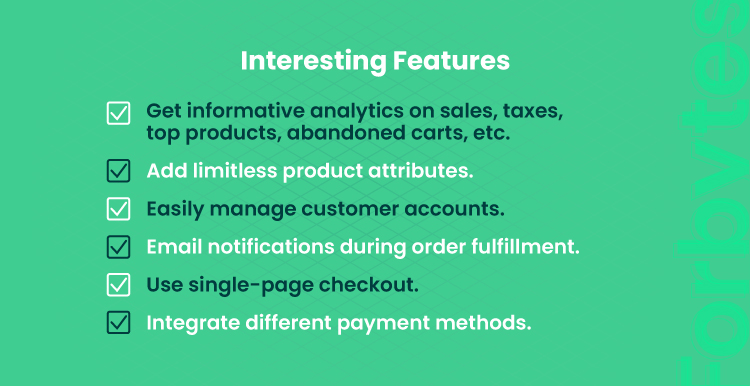
Famous Cases of Use
- Ford Motor Company. Magento is used on the Ford Motor website for retailing accessories across the globe.
- Coca-Cola. With Magento, Coca-Cola gives its customers the chance to make their purchases more personalized by putting their name onto a bottle.
- Tommy Hilfiger. The brand uses Magento to run its ecommerce operations in New Zealand and Australia. Gift cards and free shipping after the order cost reaches a particular sum are the favored features of Tommy’s website that are possible due to Magento.
Conclusion
If you are a small or medium business, Magento is a great platform for migration. Since you need to outstand the competition, the big customization opportunities that Magento gives will enable you to differentiate and make clients remember your store. If you are a big business, Magento will let you fearlessly face growing traffic when not compromising on loading speed or client experience.
WooCommerce
This is an open-source ecommerce plugin that is added to WordPress to turn a website into a real ecommerce store. It is usually preferred by small and medium-sized companies that look for a compromise between the highest price and highest quality. More than 5 million live e-stores use WooCommerce. This makes up almost 9% of all the websites on the Internet. Usually, WooCommerce is chosen by companies that want to integrate lots of content into their online stores. This, for instance, relates to the cases when a business sells products or services that require regular content publication, client education, making instructions, sharing tips, etc.
Pros
- Vast marketing opportunities. Marketing integrations of such famous tools as Google Ads, Facebook, Google Analytics, etc.
- 24 languages available. Your global audience will be pleased to see that they can choose among the most spread world languages to proceed with their orders.
- Resembles WordPress Editor. This will make the process of migration easier if you migrate from WordPress. WooCommerce also uses the principle of blocks for content management.
- eCommerce flexibility. With WooCommerce, you can sell physical goods and services and offer one-time purchases or subscriptions.
- Fee-free payment option. You may use WooCommerce Payment for transactions and pay no fee for setup or monthly use. If you don’t like this solution, you can consider other options for payment integrations.
- Growing European market. Recently, retailers started to use WooCommerce to reach the European audience. This sector only starts to grow, which means that your store will not have duplicates on the European market.
- Community of users. Let’s take Advanced WooCommerce as an example. This is a famous group that includes more than 25000 members who are skilled in WooCommerce. Here, you may find a piece of advice from marketers, website developers, managers, or designers.
Cons
- You need to host WooCommerce by yourself. This, in turn, affects the actual cost of maintenance, extensibility, and convenience of use.
- Hidden costs. Yes, WooCoppermce is an open-source platform easily downloadable for everyone. But it turns out that to get specific plugins, hosting, and themes, you need to pay. This is why before migrating, you need to review the list of the needed features and calculate expenses transparently.
- Support. WooCommerce support is less effective compared to other ecommerce platforms. Though, you may always refer to some third-party support.
Interesting Features
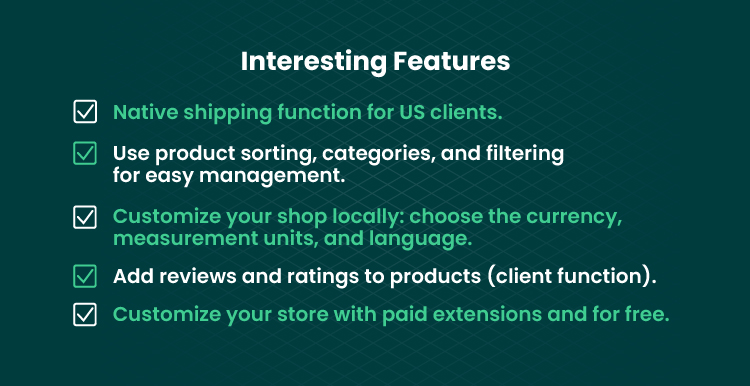
Famous Cases of Use
- Bookriot. This online store sells books across the globe and powers its website with WordPress and WooCommerce.
- IGA. This is a famous Australian service and an interesting example of WooCommerce use. Even though you cannot sell on IGA, it uses WooCommerce to let clients have the function of product reviews.
- Porter and York. This WooCommerce-powered website sells meat with the opportunity of delivering the order within 48 hours.
Conclusion
If you are using WordPress, migrating to WooCommerce makes sense as it can really help you expand your ecommerce capability. Yet, it requires a lot of effort to manage an online store on your own. So, it is always a good idea to review other options for replatforming.
To Wrap Up
Ecommerce platform migration is an effort-consuming task. But as soon as you make the right choice, you will think, “Wish I’d done it sooner.” Still, you need to understand that there is no best or worst ecommerce platform. Each of them has its strong and weak sides so you will not find the perfect and flawless solution to satisfy all your needs.
Instead, rank your needs by importance and check what ecommerce platform perfectly satisfies your most important needs and covers your most painful gaps. And if you look for help with doing this — contact Forbytes. We are an experienced ecommerce development team offering IT consulting services. Together, we can choose the best for your business and elaborate on a personalized ecommerce migration checklist.



